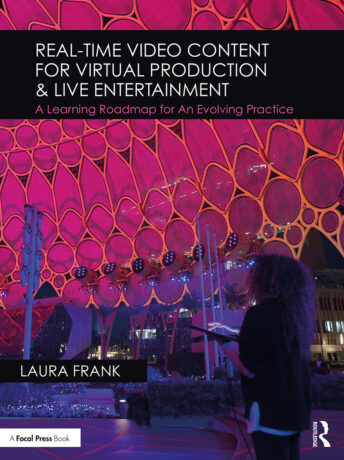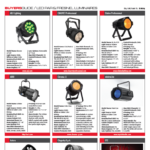
Laura Frank is a creator advocate and founder of the creative video community and resource, frame:work. As a highly regarded Screens Producer, she works worldwide on many of the most prestigious live entertainment events. Frank is also an author and recently spoke with PLSN about her new book, Real-Time Video Content For Virtual Production & Live Entertainment. It is an engaging read that lets you join Frank as she discovers the layers of an ever-evolving discipline; offering historic context while encouraging the reader to see future possibilities with new eyes.

How long have you been working on this book?
When my first book [Screens Producing & Media Operations (2019)] went to print, my editor said, ‘if you have any other ideas, please get in touch.’ And I said, ‘you know, I might have something for you.’ What I thought was going to be interesting for the future was any kind of camera-driven content creation, and of course that was the hook that everyone really leaned into with the pandemic. It was the most logical: a low crew and remote-friendly working environment to take us through the pandemic. So, the kernel of this book was already there pre-pandemic, but with the explosion of activity around real-time tool sets and XR it was Ash Nehru who finally pushed me over the edge and said, ‘just write the damn thing.’ For me, it was just a matter of finally putting that outline together and doing something with it. The timing meant that I could watch this whole thing grow; really get to capture what people were experiencing, building and learning, and get it down while it was happening. That to me is ultimately what I think this book offers; a real capture of that moment in time when people had to make this shift. I hope the book allows people who didn’t ride that wave while it was happening, a snapshot of what occurred so that they can now join in.
What does this book cover that’s different from your last book?
Well, first of all, it doesn’t have 20 years of experience in the pages. The Screens Producing & Media Operations book was really a distillation of a career’s worth of learning on a very narrow and focused topic. What this book does instead is take a field I’m not as familiar with and comes from a perspective of someone that has had a committed lifelong learning approach throughout my career. I started thinking about how would I take on something I don’t know. For me, this book tries to take the reader through what I had to go through to learn this material myself. And that starts with understanding what real-time means, where it came from, like many entertainment tool sets, we didn’t invent it. We adapted some incredible technologies that were invented elsewhere and mixed them up, using them in new ways.
I wanted to understand where those tools came from, a little of the historical context and, the different ways we’re applying them now in our fields of work. And also, I tried to put in good production ethos about being good production partners. Because, I think, anyone coming in with an interesting tool set, if they’ve arrived in the entertainment industry from other disciplines, maybe this book will offer them some insight into our culture and the appropriate ways to think about collaboration. Those are things I really value about the entertainment community but if collaboration isn’t part of your mindset coming in, I wanted to share some ideas about production philosophy. Whether you are adapting to people coming in with these XR tool sets, or you’re bringing in those XR tool sets and learning about the rest of the team, you’re going to be interacting with each other and there is a right way to do that. So really this book is in three parts: history, application, and production mindset.
Tell us what this book is not.
This book is not a how-to. I very carefully tried to say that in the book, because I don’t want someone to pick it up and think they’re going to read it and be an XR expert. This is a guide on how to learn, how to keep learning, because how do you write something about an industry that is constantly changing? It’s in the my forward to the book, I acknowledge that as soon as I published it, it’s out of date. It is evolving, this part of the industry, so I don’t want this book to be the resource of “how,” I want to be the resource of “why.” This is about people being able to approach the topic more holistically.
There is also a companion website that supports and expands upon the book. Tell us about that.
Yes, that is to answer the question, ‘how do you write about video?’ That’s ultimately why there’s a website. I got really tired of trying to explain and describe moving images and the application of those moving images. Yet it seemed important to me to outline the story in the book, describing it as best I could, and then I use the website as a living way to support those words. As this industry continues to evolve, the website can become a sort of a community project that lets us capture these moments that right now exist largely on YouTube. The companion website is really filling in those gaps of when language doesn’t do interactive video production justice, so there’s a place to go to really round out that experience of what the book is trying to convey to the reader.
Talk a bit about the case studies used in the book and about some of your contributors.
I cast a very wide net and, gratefully, I have some really wonderful contributors for case studies. I was looking for case studies that thematically supported the chapters that they’re presented in. For example, I have a chapter on background replacement tool sets, whether it’s for green screen or LED, and I have a really beautiful case study from a recent graduate of film studies at Columbia University, Fernando Ortiz. He talks about his use of background replacement in his short film thesis. Or when I’m talking about interactive installation work in another chapter, there is a really in depth case study from David [Bajt] at Bild Studios and their project at Dubai’s international Expo, [Al Wasl Dome] which is now a permanent thing and it’s the world’s largest interactive installation.
They are pieces that are all focused on real-time tools but in a range of disciplines. I try to peer into other disciplines—companion disciplines—in the book. There’s a lot of installation work in museums and for brand activations, however I’m not as familiar with those communities or that work. But I have a really great piece by Blair Neal from a project that’s over a decade old, that’s all custom coded material and about the tool sets he used. It lets readers see the different ways we think about real-time, whether it comes from the creative coding world or gaming, or how it’s being applied to film, or the way we can think about it in live production. There’s a really beautiful piece from Electronic Countermeasures about very analog, real-time content creation for the Foo Fighters tour.
I want to show that there’s a wide variety of approaches to real-time; I try to get away from just looking at the tool set that everyone’s talking about right now with XR/AR in the film and broadcast industry. But instead let people understand that real-time tools have been with us for decades and see what they look like and how they still apply. Hopefully the case studies show a wide variety of uses and a wide variety of users of these tools and the different ways they approach their work. Certainly, when I was working with the contributors I wanted to understand their approach to their clients, their approach to their teams, and how they collaborated with other departments involved in the projects that we’re working on.
What’s one thing you’d like readers of this article to take away about your book?
That this book is not going to teach you how, but instead, hopefully, it will expose you to the depth and variety of tools that entertainment borrows from and ultimately how we come together and are finding ways to make them interesting as they are used in new ways. I have a lot of love for what our community is doing and I’m excited to see where it continues to grow. In some ways the book is aspirational, I think, because I hope it is a springboard that gives readers enough of a foundation that if they’re not doing this work already, they can understand the ways that they could contribute and add value to what is happening in the community. I want this to inspire people to go learn the actual details of the tools necessary to do this work if they find from reading the book that it is what they’re interested in doing. If the book inspires them to go and learn more about this work and the industry, that would make me very happy.
Real-Time Video Content for Virtual Production & Live Entertainment, A Learning Roadmap for an Evolving Practice by Laura Frank, published by Focal Press, an imprint of Routledge, can be purchased at Amazon and Routledge.


